Battery Receiving Area
BAXIVANELIS; Konstantin ; et al.
U.S. patent application number 16/345092 was filed with the patent office on 2019-09-19 for battery receiving area. This patent application is currently assigned to Hilti Aktiengesellschaft. The applicant listed for this patent is Hilti Aktiengesellschaft. Invention is credited to Konstantin BAXIVANELIS, Tobias KOENIGER.
| Application Number | 20190283231 16/345092 |
| Document ID | / |
| Family ID | 57286280 |
| Filed Date | 2019-09-19 |




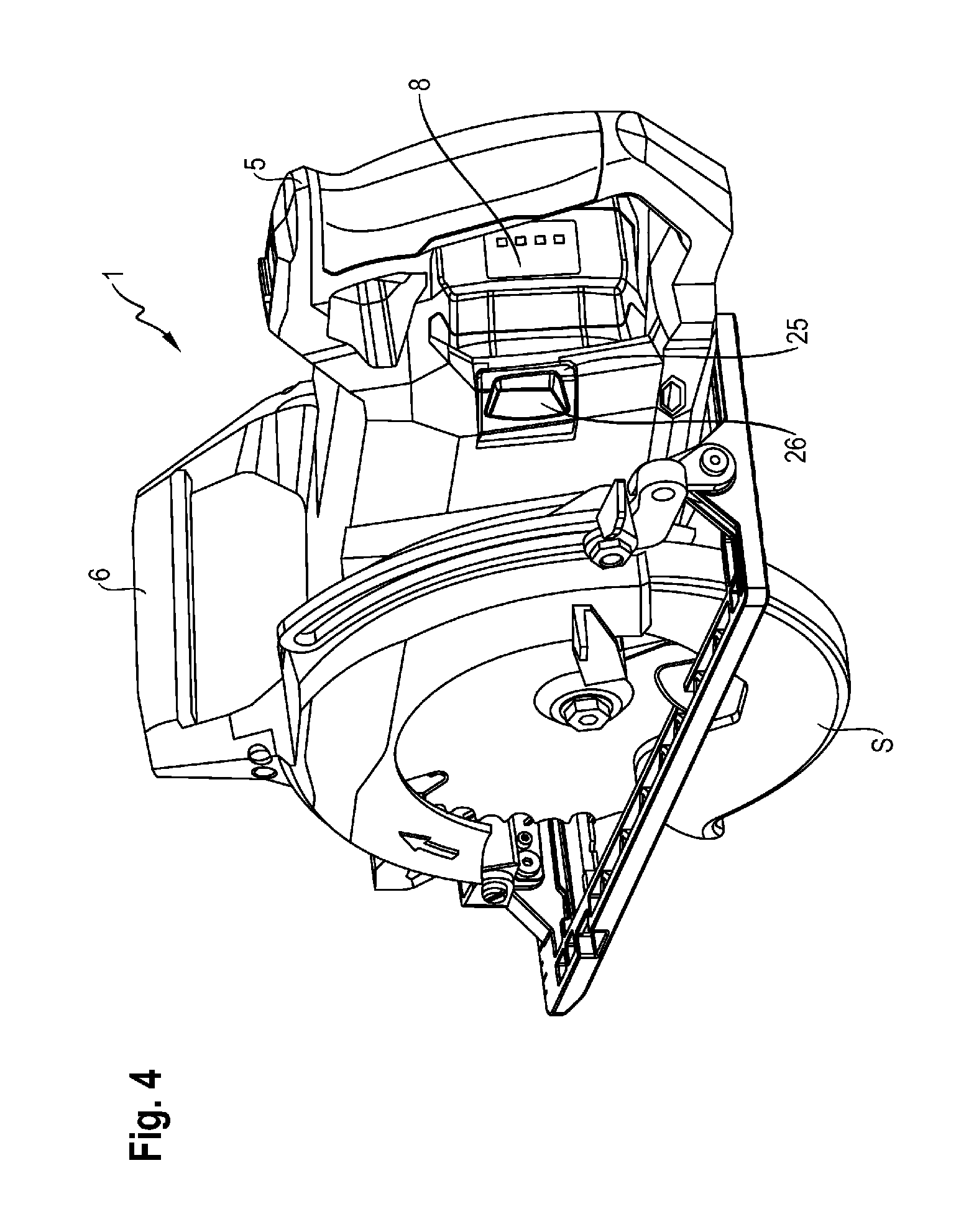

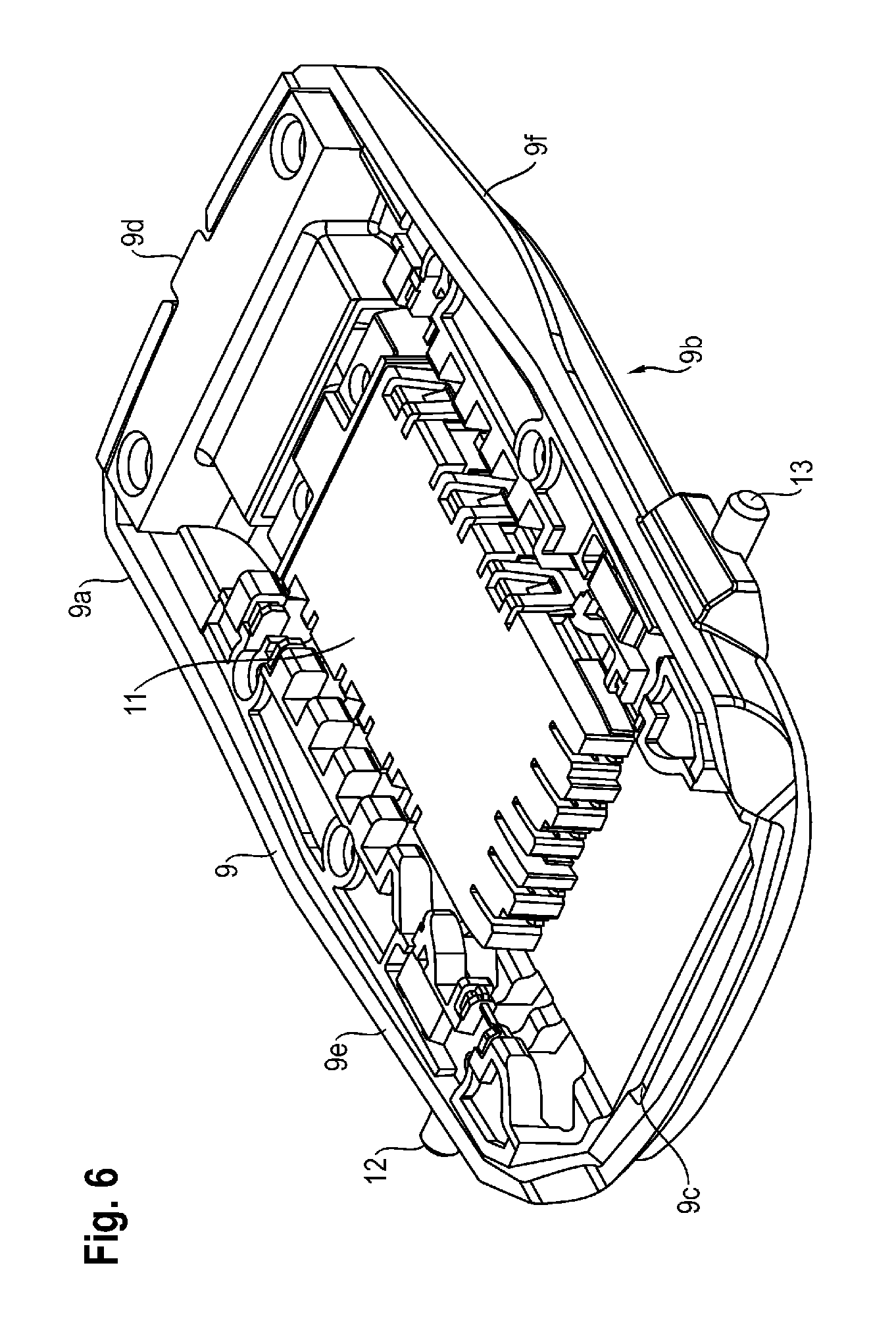

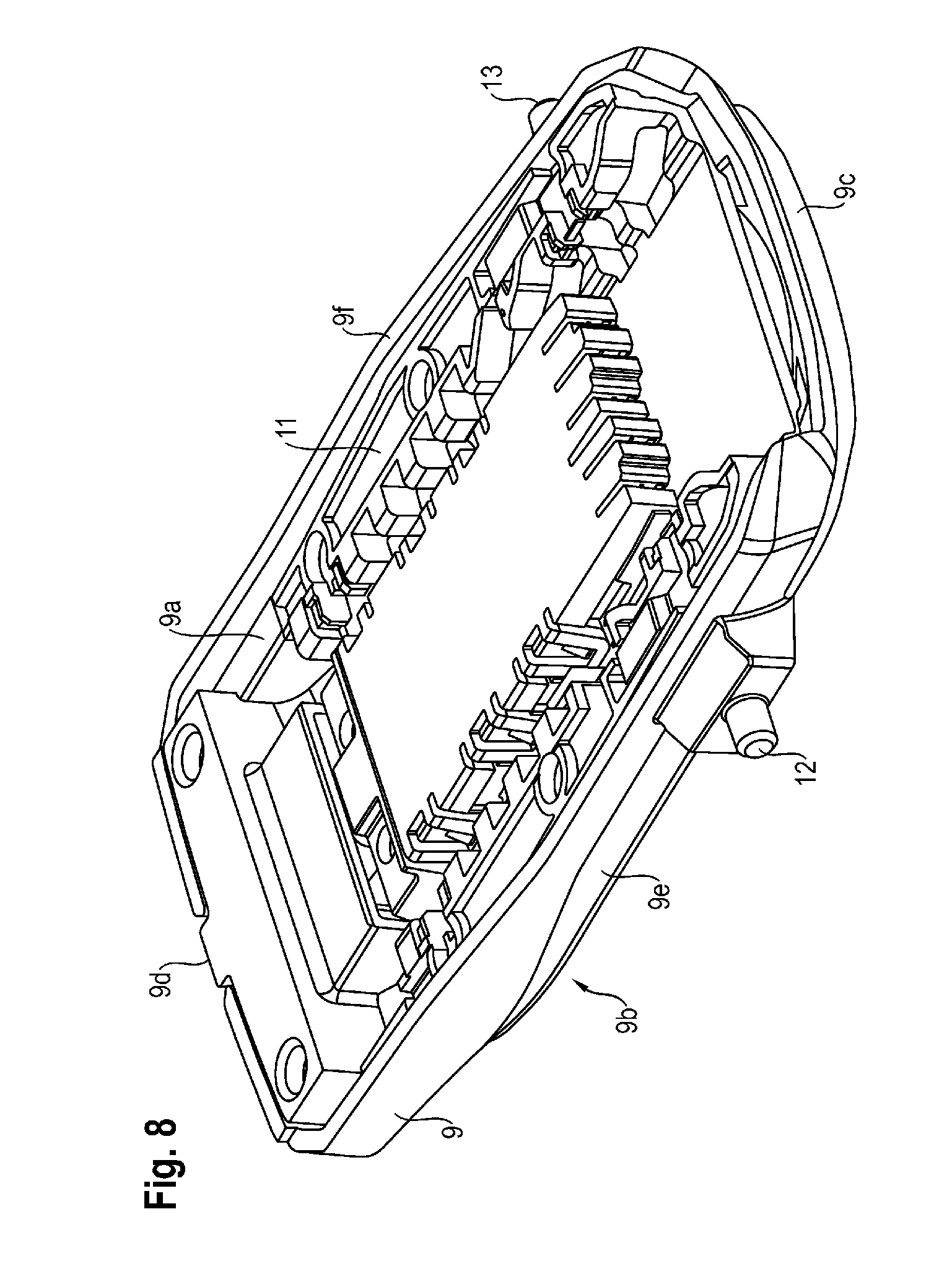
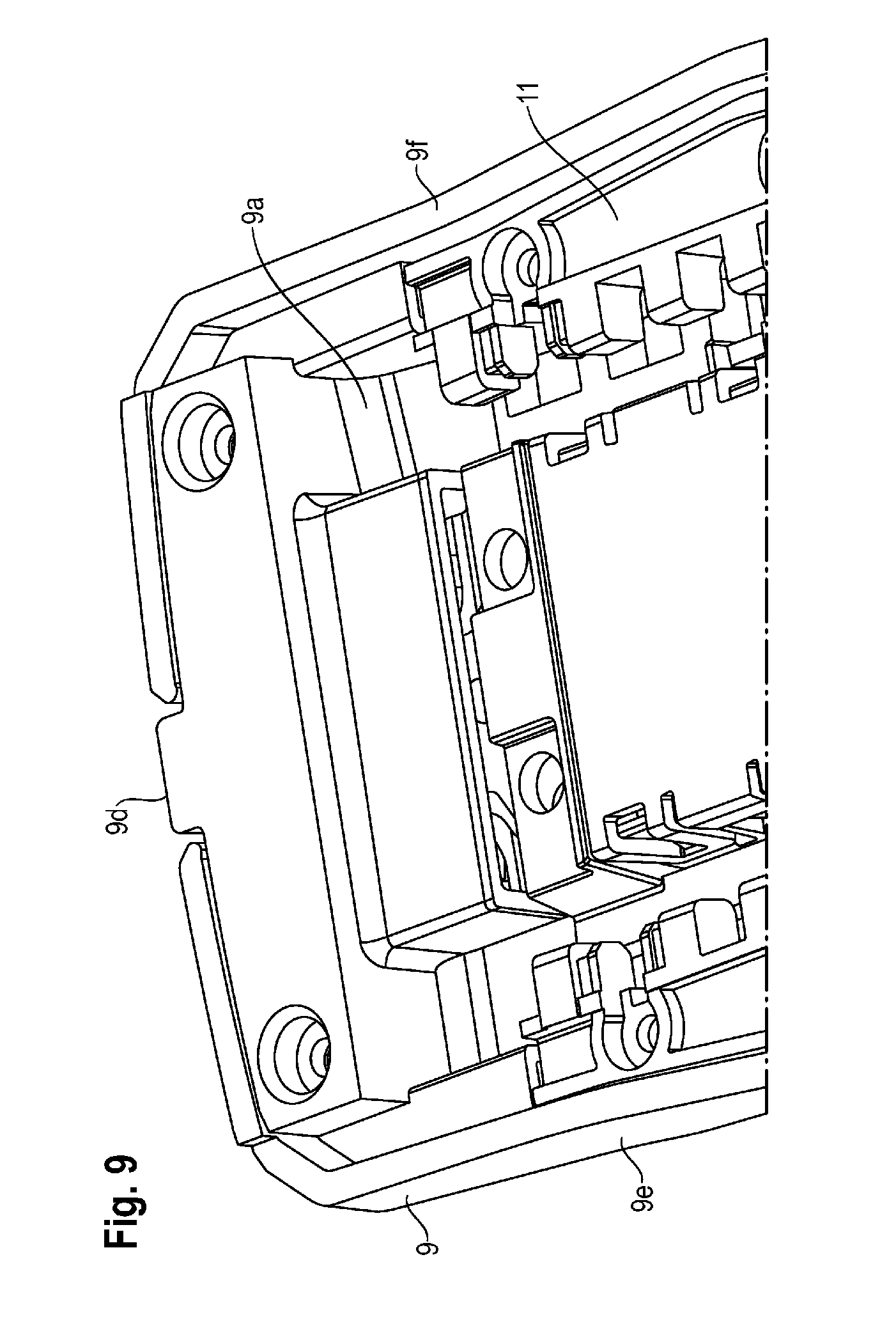

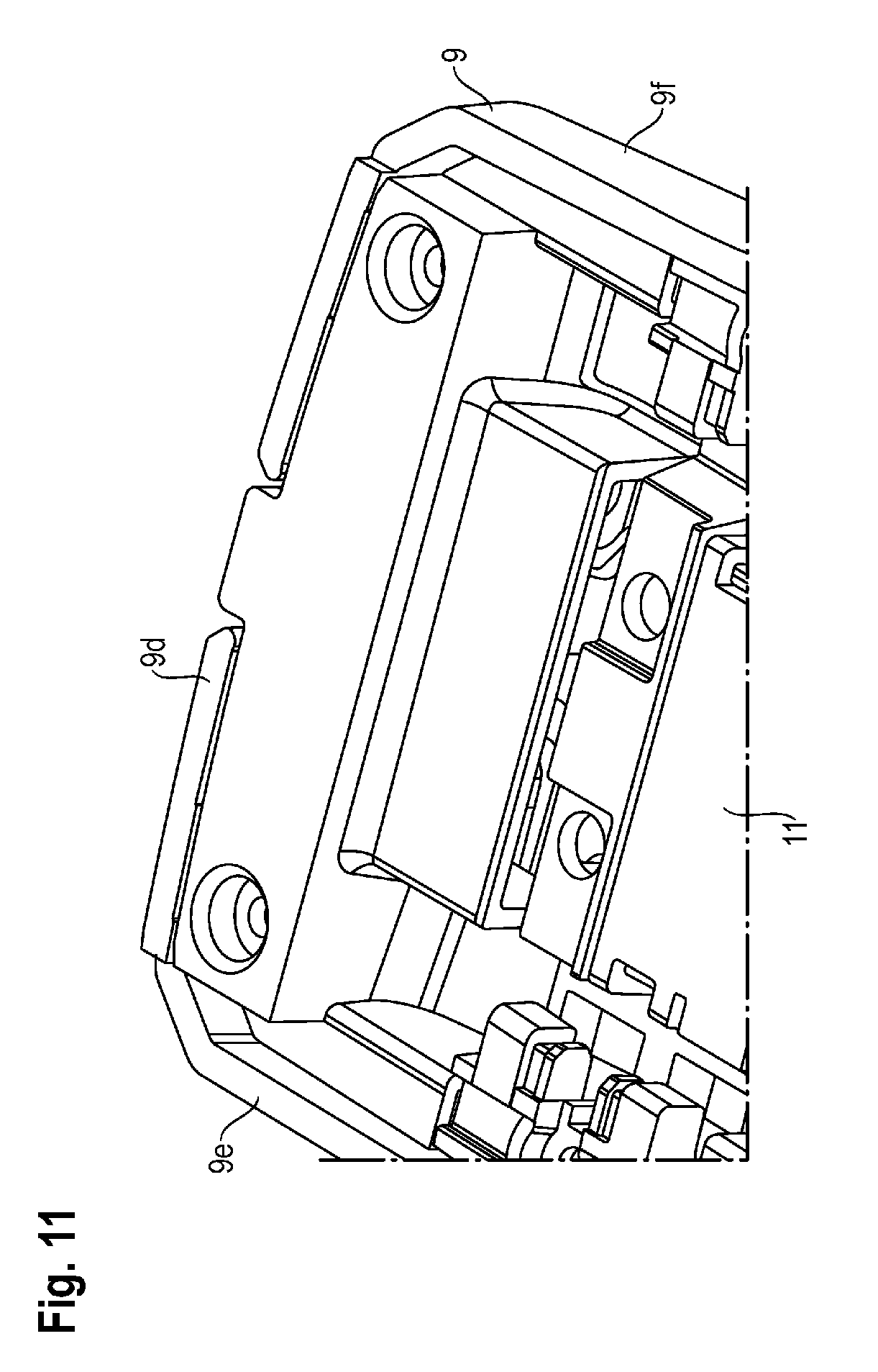
View All Diagrams
| United States Patent Application | 20190283231 |
| Kind Code | A1 |
| BAXIVANELIS; Konstantin ; et al. | September 19, 2019 |
BATTERY RECEIVING AREA
Abstract
A device for accommodating at least one battery on a power tool, in particular a circular saw, including a receiving plate for detachably holding the at least one battery, including at least one contact device for connecting the battery to the power tool, and a double hinge device having a first and a second rotation axis, the first rotation axis being positioned on a housing of the power tool, and the second rotation axis being positioned on the receiving plate, so that the receiving plate is reversibly pivotable around the first and the second rotation axis relative to the housing between a first and a second position.
| Inventors: | BAXIVANELIS; Konstantin; (Kaufering, DE) ; KOENIGER; Tobias; (Bregenz, AT) | ||||||||||
| Applicant: |
|
||||||||||
|---|---|---|---|---|---|---|---|---|---|---|---|
| Assignee: | Hilti Aktiengesellschaft Schaan LI |
||||||||||
| Family ID: | 57286280 | ||||||||||
| Appl. No.: | 16/345092 | ||||||||||
| Filed: | October 31, 2017 | ||||||||||
| PCT Filed: | October 31, 2017 | ||||||||||
| PCT NO: | PCT/EP2017/077885 | ||||||||||
| 371 Date: | April 25, 2019 |
| Current U.S. Class: | 1/1 |
| Current CPC Class: | H01M 2/1066 20130101; B23D 45/16 20130101; H01M 2220/30 20130101; B25F 5/02 20130101 |
| International Class: | B25F 5/02 20060101 B25F005/02; H01M 2/10 20060101 H01M002/10 |
Foreign Application Data
| Date | Code | Application Number |
|---|---|---|
| Nov 9, 2016 | EP | 16197919.0 |
Claims
1-2. (canceled)
3. A device for accommodating at least one battery on a power tool, the device comprising: a receiving plate for detachably holding the at least one battery, including at least one contact device for connecting the battery to the power tool; and a double hinge device having a first and a second rotation axis, the first rotation axis being positioned on a housing of the power tool, and the second rotation axis being positioned on the receiving plate, so that the receiving plate is reversibly pivotable between a first and a second position relative to the housing around the first as well as the second rotation axis.
4. The device as recited in claim 3 wherein the receiving plate contains a first and a second guide pin and the housing contains a first and a second guide groove, the first guide groove being designed to accommodate and guide the first guide pin, and the second guide groove being designed to accommodate and guide the second guide pin, so that the receiving plate is guided between the first and the second positions at least during the pivoting movement.
5. A power tool comprising: a housing; and a device for accommodating at least one battery on the power tool, the device including: a receiving plate for detachably holding the at least one battery, including at least one contact device for connecting the battery to the power tool; and a double hinge device having a first and a second rotation axis, the first rotation axis being positioned on the housing, and the second rotation axis being positioned on the receiving plate, so that the receiving plate is reversibly pivotable between a first and a second position relative to the housing around the first as well as the second rotation axis.
6. A circular saw comprising the power tool as recited in claim 5.
Description
[0001] The present invention relates to a device for accommodating at least one battery on a power tool. The power tool may be, for example, a circular saw or the like.
BACKGROUND
[0002] According to the prior art, batteries are often fastened on an underside of a housing of the power tool. However, the devices used for this purpose to detachably fasten the battery to the power tool usually have a relatively primitive or simple technical design.
[0003] A space-saving, and above all ergonomic, arrangement of the battery on the power tool often enough presents a major technical problem.
SUMMARY OF THE INVENTION
[0004] It is an object of the present invention to provide an improved device for accommodating at least one battery on a power tool, which facilitates a space-saving and ergonomic arrangement of the battery on a power tool.
[0005] The present invention provides a device for accommodating at least one battery on a power tool, in particular a circular saw.
[0006] According to the present invention, it is provided that the device includes a receiving plate for detachably holding the at least one battery, including at least one contact device for connecting the battery to the power tool, and a double hinge device having a first and second rotation axis, the first rotation axis being positioned on a housing of the power tool and the second rotation axis being positioned on the receiving plate, so that the receiving plate is reversibly pivotable between a first and a second position around the first and the second rotation axis.
[0007] According to one advantageous specific embodiment of the present invention, it may be possible for the receiving plate to contain a first and a second guide pin and for the housing to contain a first and a second guide groove, the first guide groove being designed to accommodate and guide the first guide pin, and the second guide groove being designed to accommodate and guide the second guide pin, so that the receiving plate is guided between the first and the second position at least during the pivoting movement. The secure movement of the receiving plate relative to the housing may be ensured hereby, and an excessive stressing of the double hinge device during a tilting or twisting of the receiving plate relative to the housing may be avoided.
[0008] Other advantages result from the following description of the figures. The figures illustrate different exemplary embodiments of the present invention. The figures, the description and the claims contain numerous features in combination. Those skilled in the art will advantageously also consider the features individually and combine them to form other meaningful combinations.
BRIEF DESCRIPTION OF THE DRAWINGS
[0009] In the figures, identical and equivalent components are provided with identical reference numerals.
[0010] FIG. 1 shows a first perspective view of a power tool, including a battery;
[0011] FIG. 2 shows a side view of the power tool, including the battery;
[0012] FIG. 3 shows another perspective view of the power tool, including the battery;
[0013] FIG. 4 shows another perspective view of the power tool, including the battery;
[0014] FIG. 5 shows a perspective view of the battery;
[0015] FIG. 6 shows a perspective view of a receiving plate, including a contact device of a device according to the present invention for accommodating at least one battery on a power tool;
[0016] FIG. 7 shows another perspective view of the receiving plate, including the contact device of the device according to the present invention for accommodating at least the battery on a power tool;
[0017] FIG. 8 shows another perspective view of the receiving plate, including the contact device of the device according to the present invention for accommodating at least the battery on the power tool;
[0018] FIG. 9 shows a partial view of a rear end of the receiving plate, including the contact device;
[0019] FIG. 10 shows another partial view of the rear end of the receiving plate, including part of the contact device;
[0020] FIG. 11 shows another partial view of the rear end of the receiving plate, including part of the contact device;
[0021] FIG. 12 shows another partial view of the rear end of the receiving plate, including part of the contact device;
[0022] FIG. 13 shows a view from below of the rear end of the receiving plate, without the contact device;
[0023] FIG. 14 shows another view from below of the rear end of the receiving plate, including part of the contact device;
[0024] FIG. 15 shows another partial view of the rear end of the receiving plate, including part of the contact device;
[0025] FIG. 16 shows a view from below of the entire receiving plate, including the contact device;
[0026] FIG. 17 shows a side view of the entire receiving plate, including the contact device;
[0027] FIG. 18 show another perspective view of the receiving plate, without the contact device;
[0028] FIG. 19 shows a perspective view of the contact device;
[0029] FIG. 20 shows another perspective view of the contact device;
[0030] FIG. 21 shows another perspective view of the contact device;
[0031] FIG. 22 shows a perspective partial view of a housing of the power tool;
[0032] FIG. 23 shows another perspective partial view of the housing of the power tool, including a double hinge device in a first position;
[0033] FIG. 24 shows another perspective partial view of the housing of the power tool, including a double hinge device in a first position;
[0034] FIG. 25 shows another perspective partial view of the housing of the power tool, including a double hinge device in a second position;
[0035] FIG. 26 shows another perspective partial view of the housing of the power tool, including a double hinge device in a second position;
[0036] FIG. 27 shows a perspective view of the housing of the power tool, including the receiving plate in a first position;
[0037] FIG. 28 shows another perspective view of the housing of the power tool, including the receiving plate in the first position;
[0038] FIG. 29 shows another perspective view of the housing of the power tool, including the receiving plate in the first position;
[0039] FIG. 30 shows another perspective view of the housing of the power tool, including the receiving plate and the contact device in the first position;
[0040] FIG. 31 shows a perspective partial view of the housing of the power tool, including the receiving plate and the contact device in the first position;
[0041] FIG. 32 shows another perspective partial view of the housing of the power tool, including the receiving plate and the contact device in the first position;
[0042] FIG. 33 shows a perspective view of the housing of the power tool, including the receiving plate and the contact device in the second position; and
[0043] FIG. 34 shows a perspective view of the housing of the power tool, including the receiving plate and the battery in the second position.
DETAILED DESCRIPTION
[0044] FIGS. 1 through 4 show a power tool 1 and a device 2 for accommodating at least one battery 8 on power tool 1, in particular a circular saw. However, it is also possible for it to be any other suitable power tool.
[0045] In the present embodiment, power tool 1 is designed in the form of a circular saw and essentially includes a housing 4, a first rear handle 5, a second upper handle 6 and a saw blade S. Power tool 1 designed as a circular saw may be guided by the user by the two handles 5, 6. The user is not illustrated in the figures.
[0046] Housing 4 has an indentation 7, in which battery 8 may be accommodated and held. Indentation 7 may also be referred to as a recess. As shown in FIG. 5, battery 8 is designed in the shape of a cuboid. Two rails 8b, 8c and a contact element 8d are positioned on an upper side 8a. Rails 8b are used to be able to push battery 8 onto power tool 1 in a corresponding location.
[0047] Device 2 for accommodating at least one battery 8 on power tool 1 essentially includes a receiving plate 9 and a double hinge device 10.
[0048] As illustrated in FIGS. 6 through 18, receiving plate 9 is essentially designed in the form of a flat, shell-shaped plate. Receiving plate 9 is used for detachably holding battery 8 with the aid of indentation 7 of power tool 1. Receiving plate 9 has an upper side 9a, an underside 9b, a front side 9c, a back side 9d, a first side wall 9e and a second side wall 9f. A contact device 11 is furthermore positioned on upper side 9a of receiving plate 9.
[0049] As illustrated in FIGS. 19 through 21, contact device 11 has a flat design and includes two recesses 11a, 11b and a connecting element 11c. Accordingly, the two rails 8b, 8c of battery 8 may be inserted into the two recesses 11a, 11b, so that battery 8 is detachably fastened on contact device 11 and on receiving plate 9. When battery 8 is pushed all the way onto contact device 11, contact element 8d on upper side 8a of battery 8 is in contact with connecting element 11c of contact device 11. Contact device 11 includes both mechanical and electrical contact elements.
[0050] In addition, receiving plate 9 contains a first and a second guide pin 12, 13 (cf. FIG. 6). First guide pin 12 is positioned on first side wall 9e, and second guide pin 13 is positioned on second side wall 9f. Both first and second guide pins 12, 13 extend in the same plane as the flat, shell-shaped plate of receiving plate 9 or contact device 11 (cf. FIGS. 6 through 9). Moreover, receiving plate 9 contains a third and a fourth guide pin 14, 15 on underside 9b. Third guide pin 14 is positioned on an end of a first web 16, and fourth guide pin 15 is positioned on an end of a second web 17. First and second webs 16, 17 run in a plane perpendicular to the plane of receiving plate 9 and contact device 11 (cf. FIGS. 14 and 15).
[0051] As already mentioned above, housing 4 of power tool 1 has an indentation 7, in which battery 8 may be accommodated and held with the aid of receiving plate 9. As described in greater detail below, receiving plate 9 may be reversibly pivoted relative to indentation 7 between a first and a second position. For example, FIG. 28 shows receiving plate 9 in the first position, and FIG. 33 shows receiving plate 9 in the second position.
[0052] Indentation 7 essentially contains a first side wall 7a, a second side wall 7b, a base 7c and a back wall 7d (cf. FIGS. 22 through 30). Indentation 7 accommodates battery 8 in that receiving plate 9 is positioned in indentation 7, and battery 8 is pushed onto receiving plate 9. Indentation 7 is dimensioned in such a way that receiving plate 9 and at least part of battery 8 may be accommodated. Base 7c of indentation 7 is in parallel to upper side and underside 9a, 9b of receiving plate 9 when receiving plate 9 is in the first position. In the first position, receiving plate 9 is also in parallel to saw blade S (cf. FIGS. 27 and 28). First side wall 7a of indentation 7 contains a first guide groove 18, and second side wall 7b of indentation 7 contains a second guide groove 19. First guide groove 18 is designed to accommodate and guide first guide pin 12, and second guide groove 19 is designed to accommodate and guide second guide pin 13. Both first and second guide grooves 18, 19 have a slightly S-shaped course. Moreover, indentation 7 has a recess 20 on one end of the base, in which a connecting element 21 of double hinge device 10 is positioned. Double hinge device 10 has a first and a second rotation axis A, B, first rotation axis A being positioned on a housing 4 of power tool 1, and second rotation axis B being positioned on receiving plate 9, so that receiving plate 9 is reversibly pivotable between a first and a second position relative to housing 4 around first as well as second rotation axis A, B.
[0053] Connecting element 21 includes a first and a second pivot bearing 22, 23 for correspondingly accommodating third and fourth guide pins 14, 15 of receiving plate 9. As is apparent in FIG. 22, first rotation axis A is situated on base 7c of indentation 7, so that connecting element 21 may be pivoted between the first and the second position relative to base 7c of indentation 7 (cf. FIGS. 22 and 25).
[0054] Second rotation axis B is formed by first and second pivot bearings 22, 23 as well as by third and fourth guide pins 14, 15. Connecting element 21 and receiving plate 9 may be pivoted relative to each other with the aid of second rotation axis B.
[0055] In FIGS. 22 through 24, connecting element 21 of double hinge device 10 is shown in the first position. In the first position, connecting element 21 lies flat against base 7c of indentation 7 and almost completely fills recess 20 on base 7c of indentation 7.
[0056] In FIGS. 25 and 26, connecting element 21 of double hinge device 10 is shown in the second position. In the second position, connecting element 21 is essentially situated perpendicularly to base 7c of indentation 7 and extends out of recess 20 on base 7c of indentation 7.
[0057] Indentation 7 also contains a spring and a closing mechanism 25. As illustrated in FIGS. 22 through 26, spring 24 is designed in the form of a spiral spring and extends from base 7c of indentation 7. When receiving plate 9 is positioned in indentation 7, spring 24 is situated between base 7c of indentation 7 on underside 9b of receiving plate 9. The spring force of spring 24 presses receiving plate 9 away from base 7c of indentation 7 in arrow direction A.
[0058] Closing mechanism 25 is also positioned on base 7c of indentation 7 and is used to hold receiving plate 9 on base 7c of indentation 7 and in the first position against the spring force of spring 24. A release element 26 for closing mechanism 25 is illustrated in FIGS. 4 and 22.
[0059] As already mentioned above, receiving plate 9 may be reversibly moved between a first and a second position relative to indentation 7. When receiving plate 9, together with contact device 11, is in the first position, and battery 8 has been pushed onto contact device 11, receiving plate 9 is situated in parallel on base 7c of indentation 7, and battery 8 is connected in a space-saving and ergonomic manner to power tool 1 designed as a circular saw.
[0060] When receiving plate 9, together with contact device 11, is in the second position and battery 8 is pushed onto contact device 11, receiving plate 9 is at an angle .alpha. with respect to base 7c of indentation 7 (cf. FIGS. 33 and 34). In the second position, battery 8 may be pulled past first rear handle 5 and out of contact device 11 or away from receiving plate 9 in arrow direction B. The second position is also used to push a battery 8 into contact device 11 or onto receiving plate 9 to connect it to power tool 1 as an energy source.
[0061] To be able to pivot receiving plate 9 between the first and the second position relative to indentation 7, third guide pin 14 of receiving plate 9 is positioned in first pivot bearing 22 of connecting element 21, and fourth guide pin 15 of receiving plate 9 is positioned in second pivot bearing 23 of connecting element 21 of double hinge device 10. First guide pin 12 is positioned in first guide groove 18, and second guide pin 13 is positioned in second guide groove 19 (cf. FIGS. 27 through 32).
[0062] When receiving plate 9 is pivoted from the first position to the second position, first guide pin 12 travels along first guide groove 18, and second guide pin 13 travels along second guide groove 19. Double hinge device 10 causes receiving plate 9 to be pivotable around first and second rotation axes A, B in a particularly space-saving manner.
* * * * *
D00000

D00001

D00002

D00003

D00004

D00005

D00006

D00007

D00008

D00009

D00010

D00011

D00012

D00013
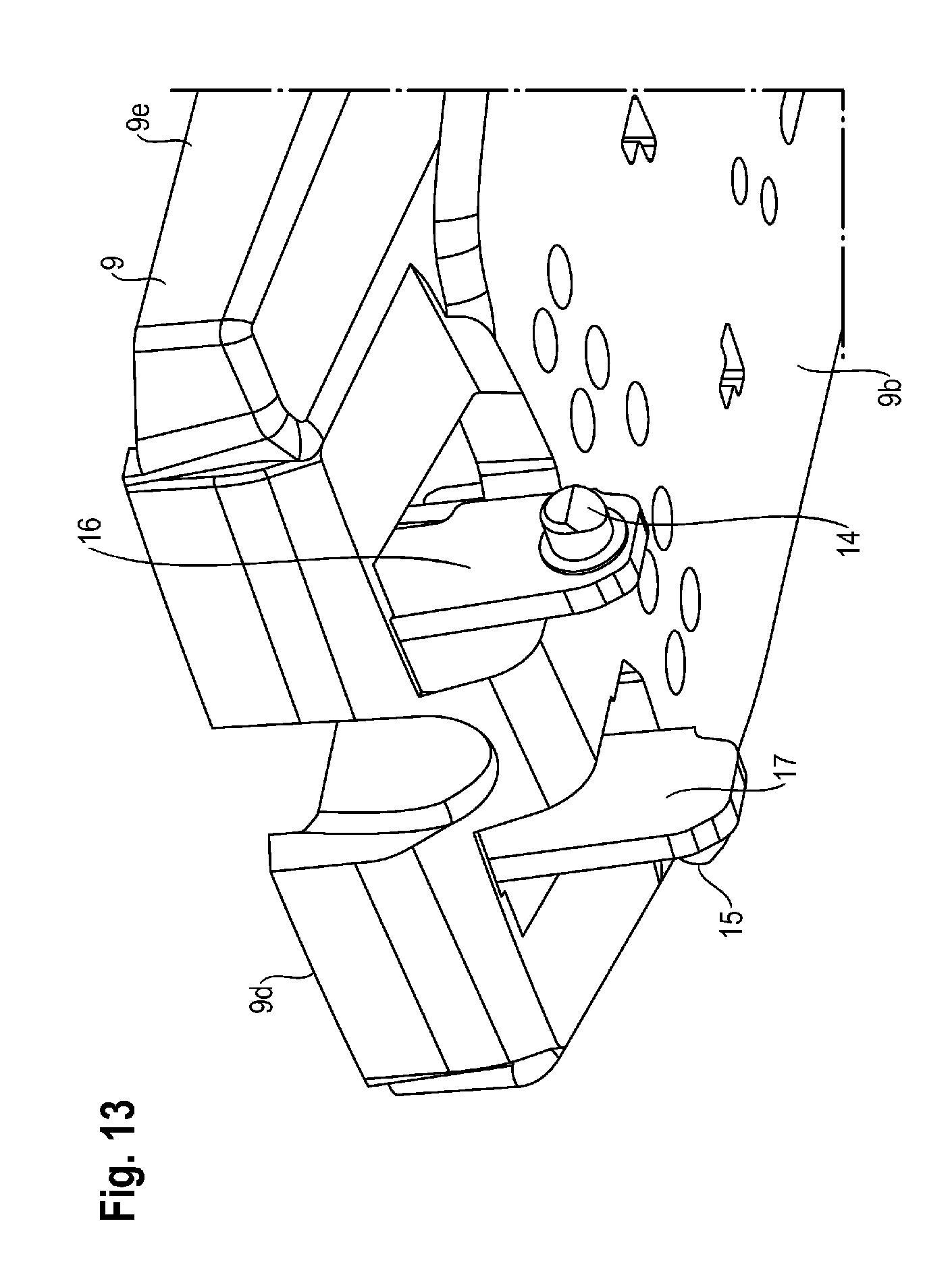
D00014
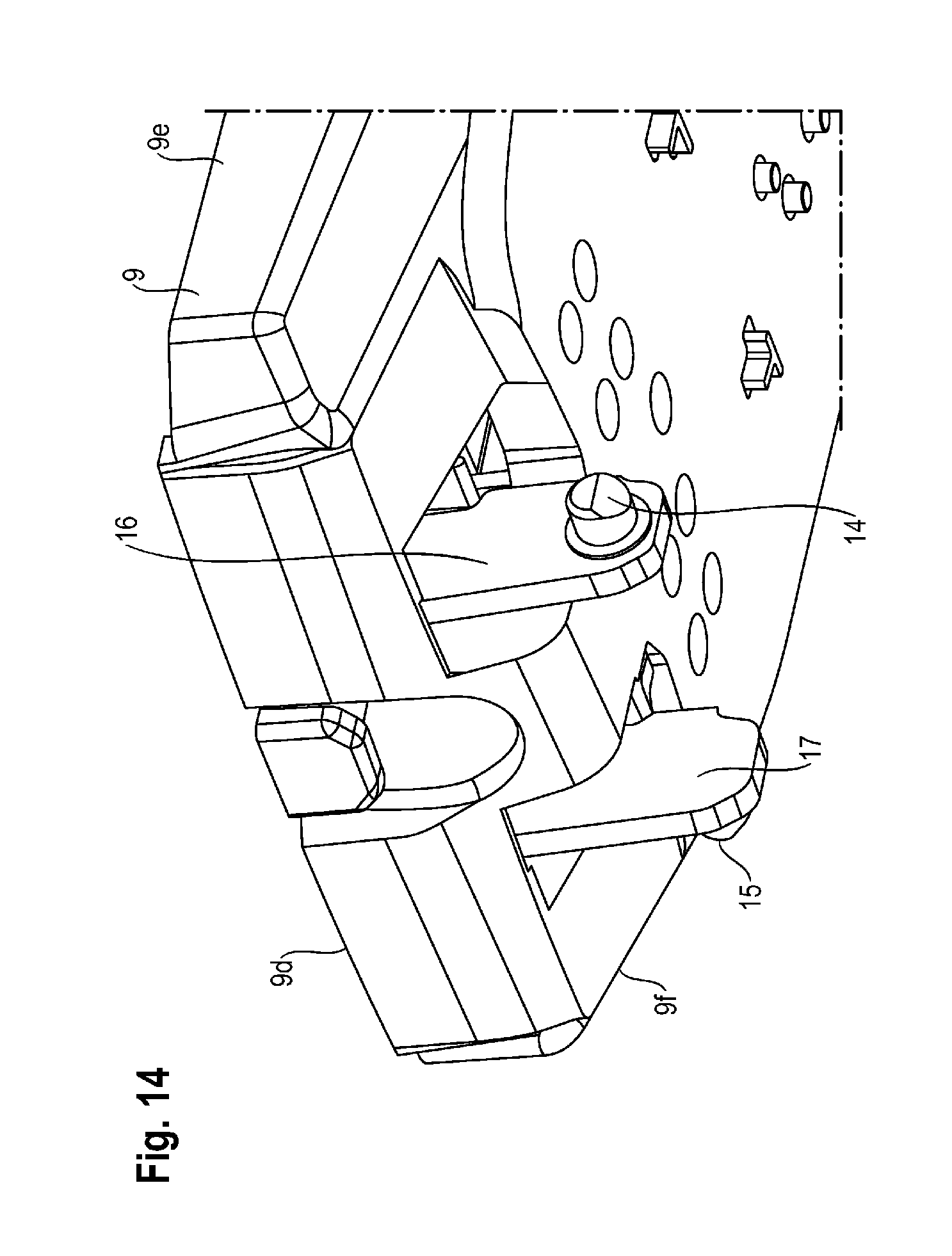
D00015

D00016
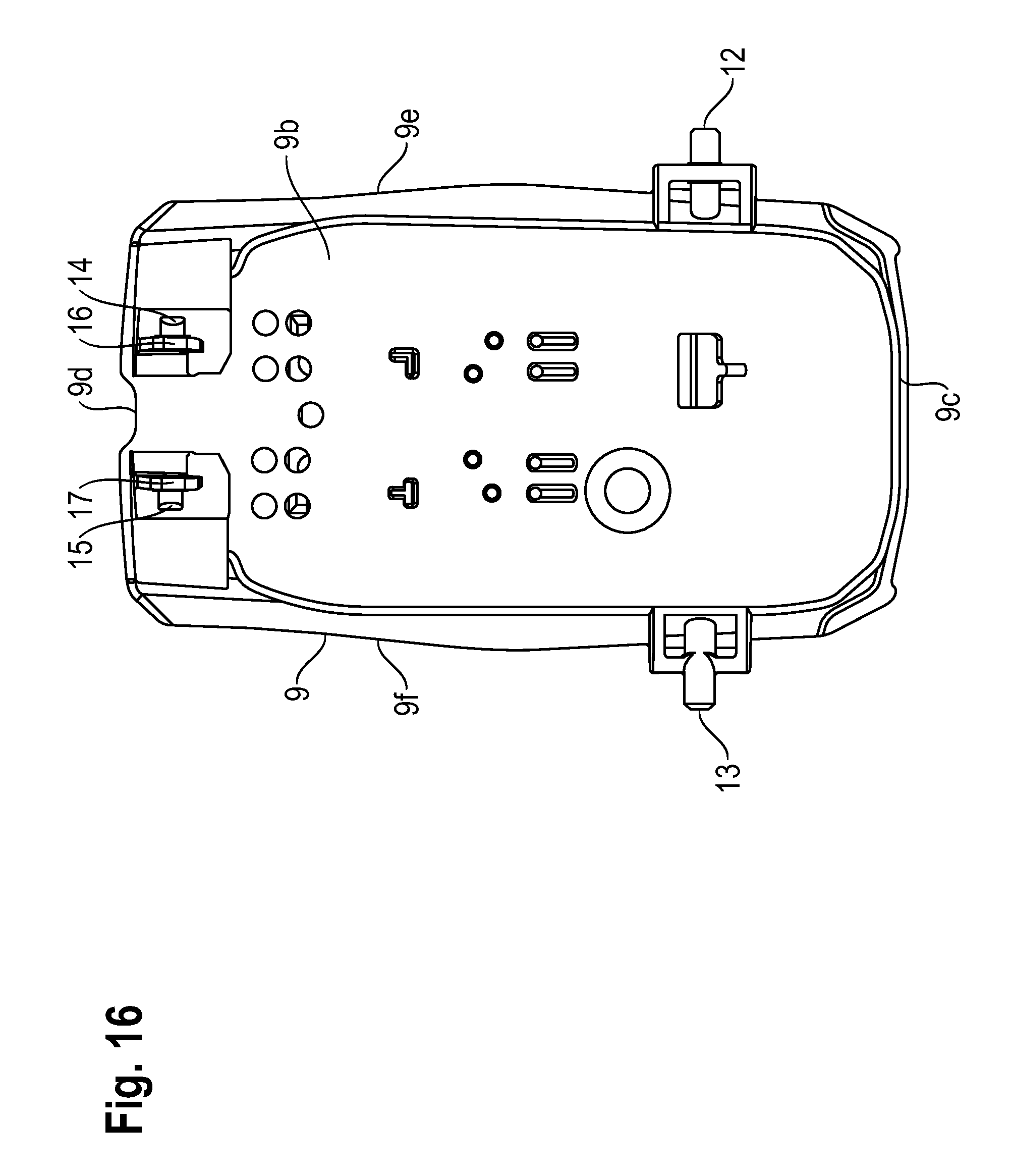
D00017

D00018

D00019

D00020

D00021
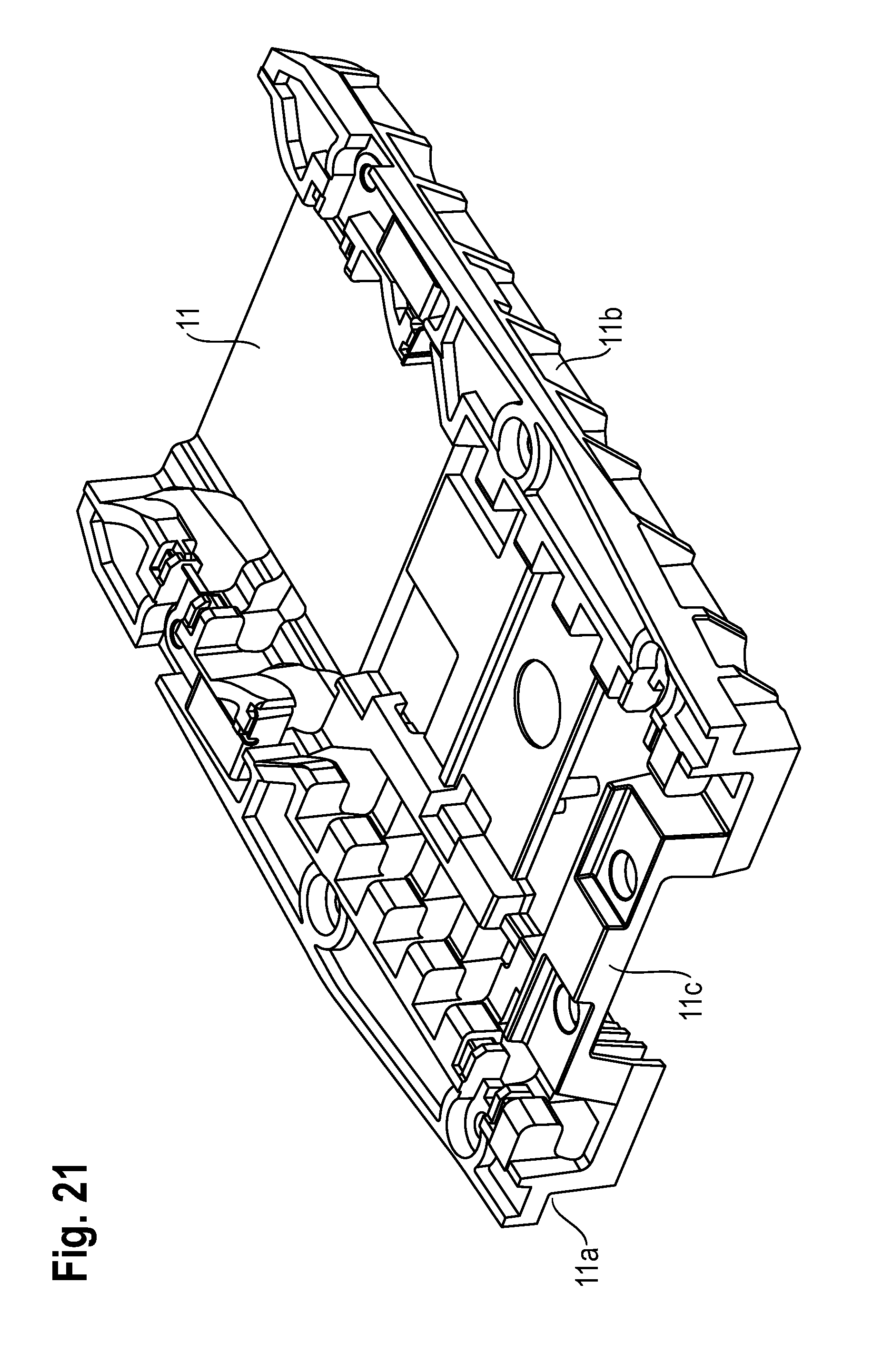
D00022

D00023
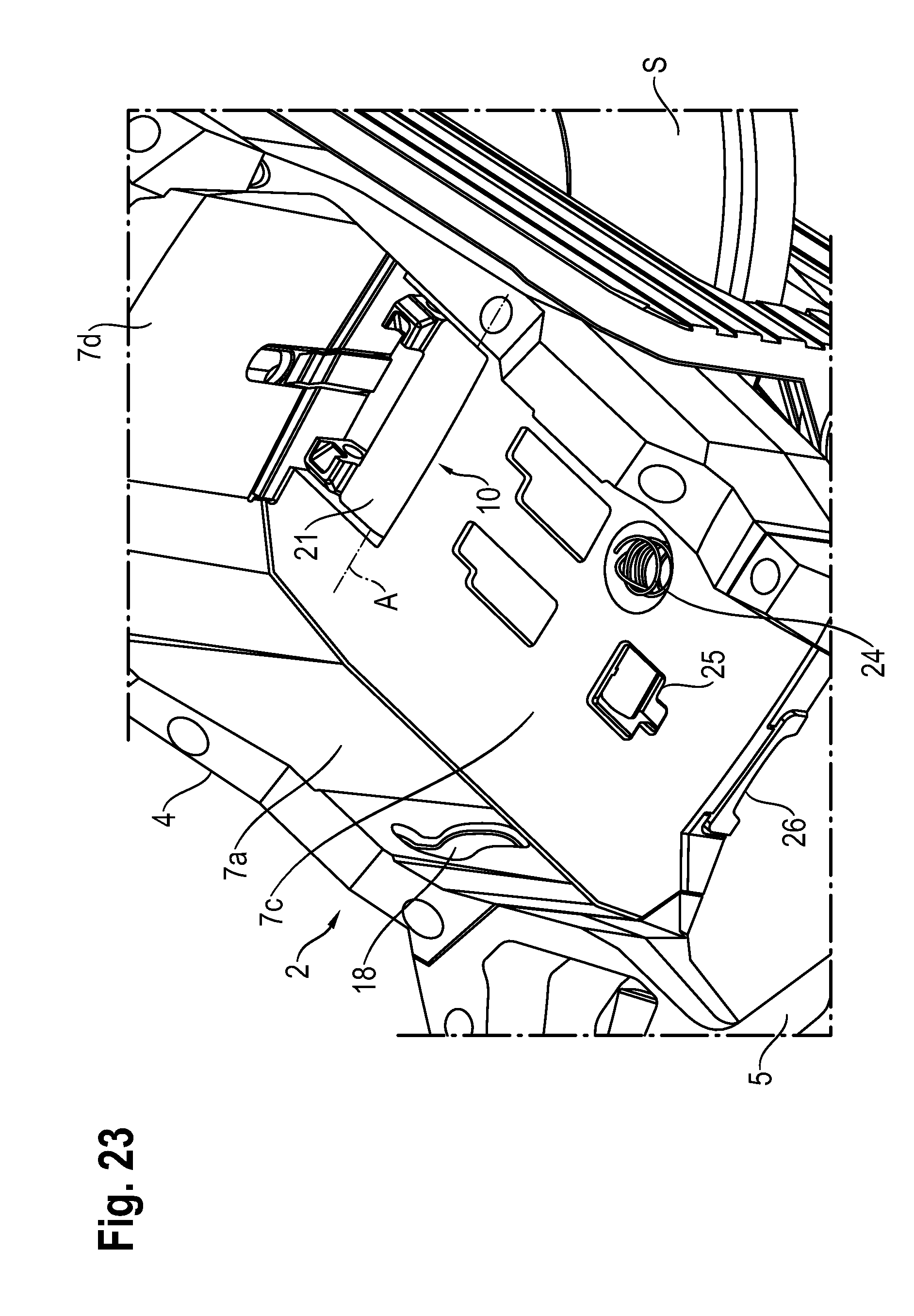
D00024
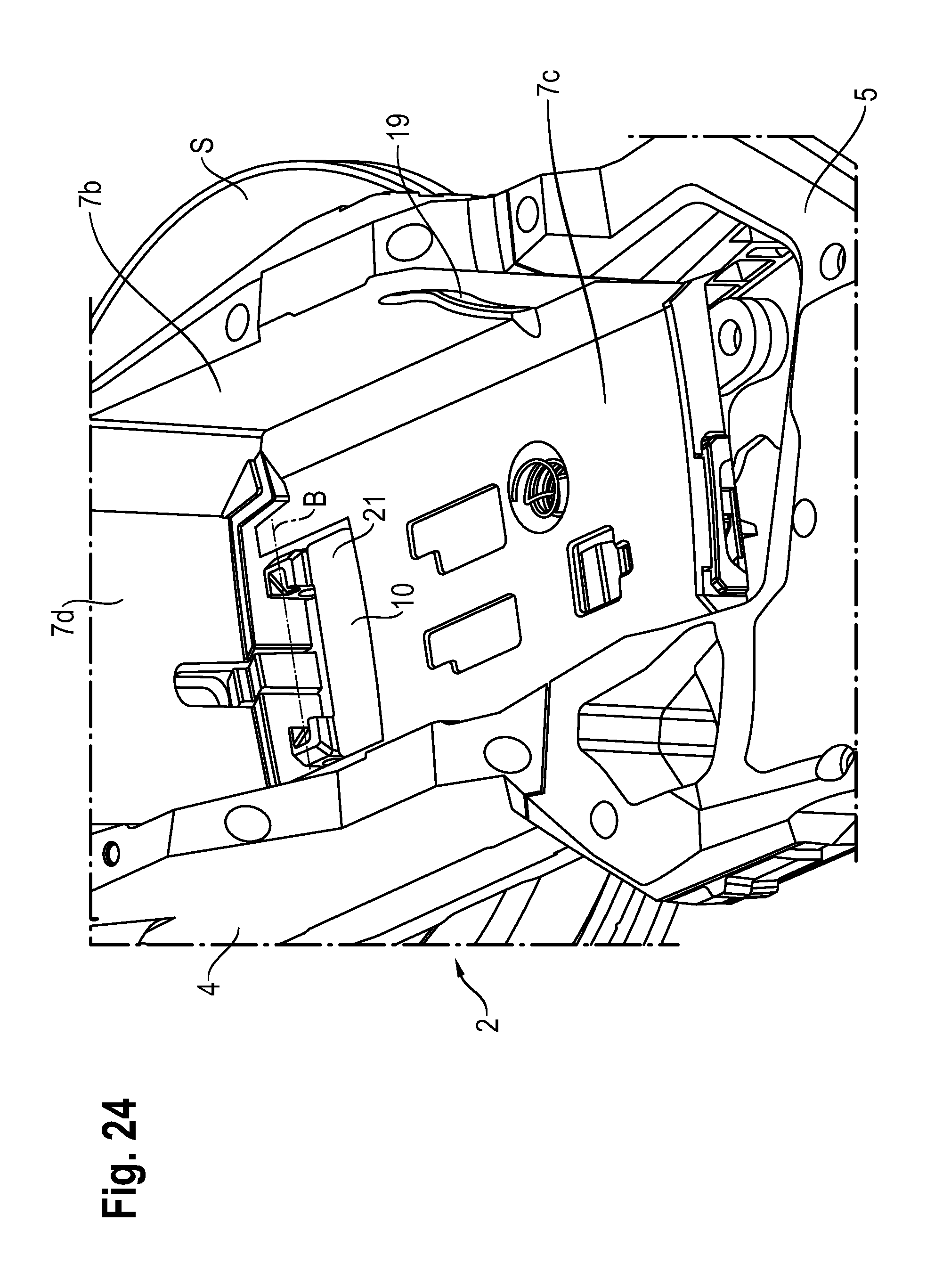
D00025

D00026

D00027

D00028
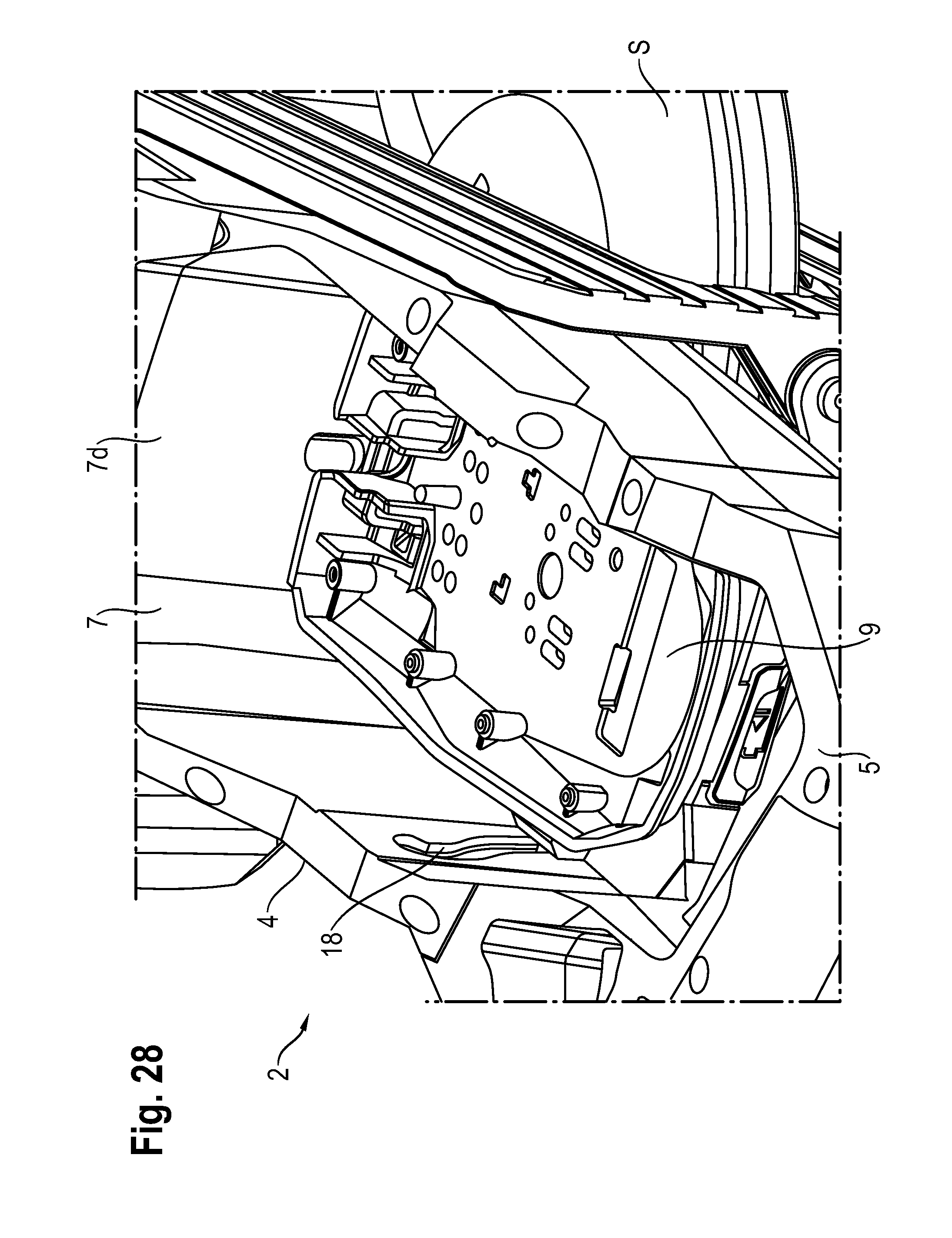
D00029

D00030

D00031

D00032
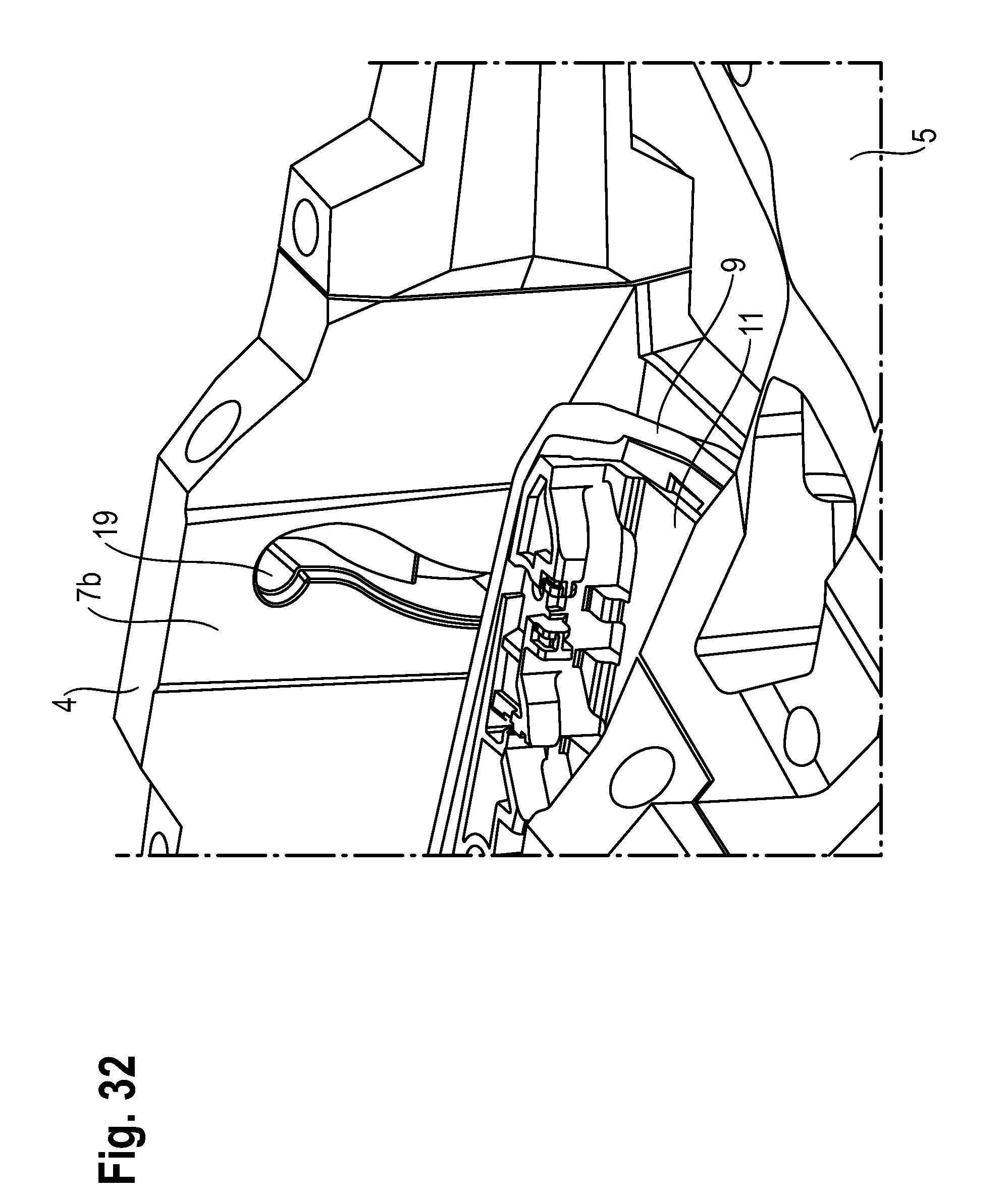
D00033

D00034
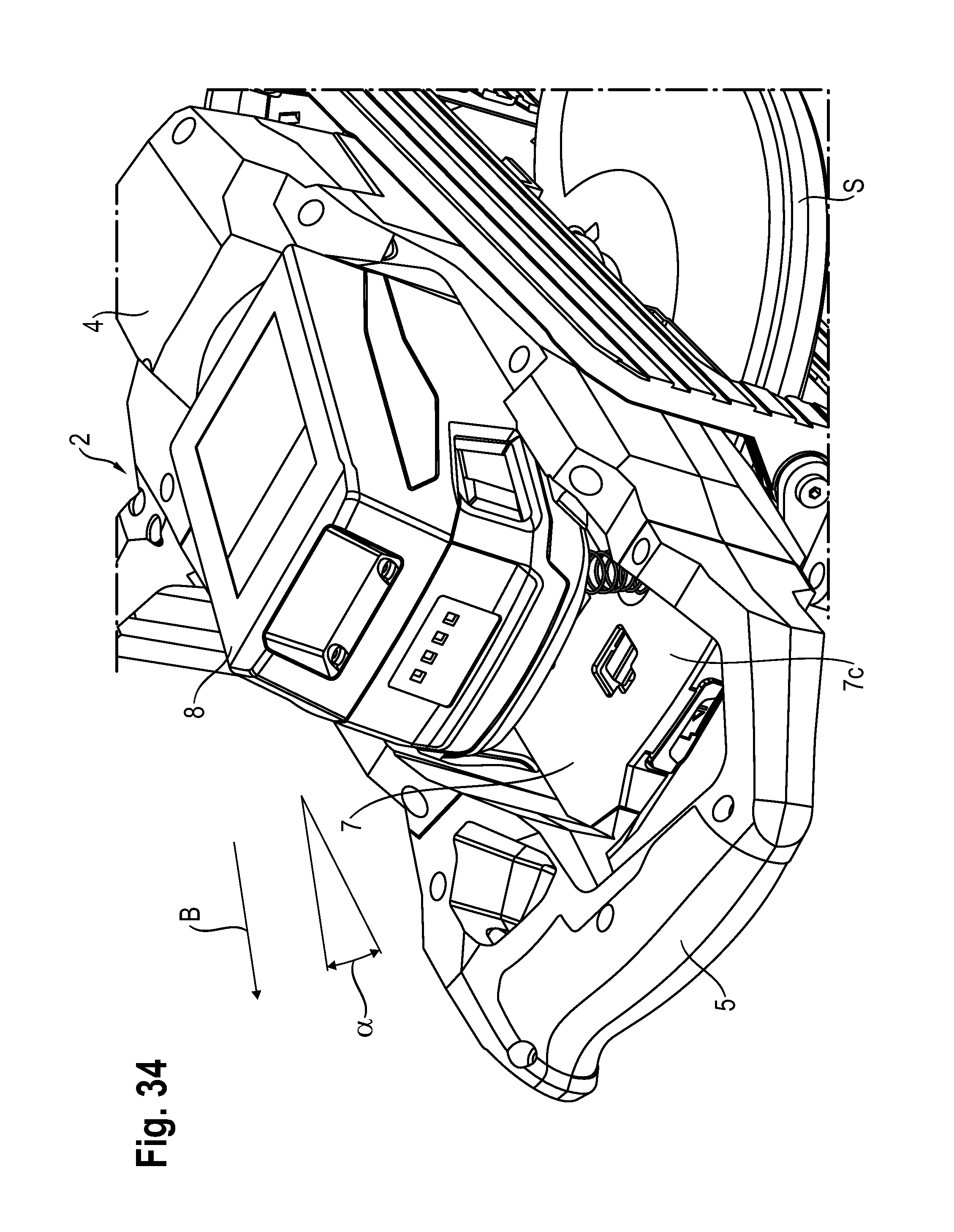
XML
uspto.report is an independent third-party trademark research tool that is not affiliated, endorsed, or sponsored by the United States Patent and Trademark Office (USPTO) or any other governmental organization. The information provided by uspto.report is based on publicly available data at the time of writing and is intended for informational purposes only.
While we strive to provide accurate and up-to-date information, we do not guarantee the accuracy, completeness, reliability, or suitability of the information displayed on this site. The use of this site is at your own risk. Any reliance you place on such information is therefore strictly at your own risk.
All official trademark data, including owner information, should be verified by visiting the official USPTO website at www.uspto.gov. This site is not intended to replace professional legal advice and should not be used as a substitute for consulting with a legal professional who is knowledgeable about trademark law.